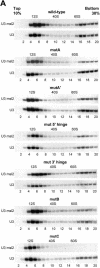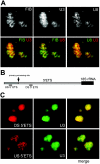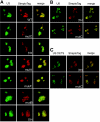Role of pre-rRNA base pairing and 80S complex formation in subnucleolar localization of the U3 snoRNP
- PMID: 15367679
- PMCID: PMC516741
- DOI: 10.1128/MCB.24.19.8600-8610.2004
Role of pre-rRNA base pairing and 80S complex formation in subnucleolar localization of the U3 snoRNP
Abstract
In the nucleolus the U3 snoRNA is recruited to the 80S pre-rRNA processing complex in the dense fibrillar component (DFC). The U3 snoRNA is found throughout the nucleolus and has been proposed to move with the preribosomes to the granular component (GC). In contrast, the localization of other RNAs, such as the U8 snoRNA, is restricted to the DFC. Here we show that the incorporation of the U3 snoRNA into the 80S processing complex is not dependent on pre-rRNA base pairing sequences but requires the B/C motif, a U3-specific protein-binding element. We also show that the binding of Mpp10 to the 80S U3 complex is dependent on sequences within the U3 snoRNA that base pair with the pre-rRNA adjacent to the initial cleavage site. Furthermore, mutations that inhibit 80S complex formation and/or the association of Mpp10 result in retention of the U3 snoRNA in the DFC. From this we propose that the GC localization of the U3 snoRNA is a direct result of its active involvement in the initial steps of ribosome biogenesis.
Figures






Similar articles
-
Trypanosoma brucei 5'ETS A'-cleavage is directed by 3'-adjacent sequences, but not two U3 snoRNA-binding elements, which are all required for subsequent pre-small subunit rRNA processing events.J Mol Biol. 2001 Nov 2;313(4):733-49. doi: 10.1006/jmbi.2001.5078. J Mol Biol. 2001. PMID: 11697900
-
U3 small nucleolar RNA is essential for cleavage at sites 1, 2 and 3 in pre-rRNA and determines which rRNA processing pathway is taken in Xenopus oocytes.J Mol Biol. 1999 Mar 12;286(5):1347-63. doi: 10.1006/jmbi.1999.2527. J Mol Biol. 1999. PMID: 10064702
-
Alterations of nucleolar ultrastructure and ribosome biogenesis by actinomycin D. Implications for U3 snRNP function.Eur J Cell Biol. 1992 Jun;58(1):149-62. Eur J Cell Biol. 1992. PMID: 1386570
-
Mpp10p, a new protein component of the U3 snoRNP required for processing of 18S rRNA precursors.Nucleic Acids Symp Ser. 1997;(36):64-7. Nucleic Acids Symp Ser. 1997. PMID: 9478208 Review.
-
U3 snoRNA may recycle through different compartments of the nucleolus.Chromosoma. 1997 Jun;105(7-8):401-6. doi: 10.1007/BF02510476. Chromosoma. 1997. PMID: 9211967 Review.
Cited by
-
Structural and functional analysis of the U3 snoRNA binding protein Rrp9.RNA. 2013 May;19(5):701-11. doi: 10.1261/rna.037580.112. Epub 2013 Mar 18. RNA. 2013. PMID: 23509373 Free PMC article.
-
Small Nucleolar RNAs: Insight Into Their Function in Cancer.Front Oncol. 2019 Jul 9;9:587. doi: 10.3389/fonc.2019.00587. eCollection 2019. Front Oncol. 2019. PMID: 31338327 Free PMC article. Review.
-
RNA-based affinity purification reveals 7SK RNPs with distinct composition and regulation.RNA. 2007 Jun;13(6):868-80. doi: 10.1261/rna.565207. Epub 2007 Apr 24. RNA. 2007. PMID: 17456562 Free PMC article.
-
Sequence and generation of mature ribosomal RNA transcripts in Dictyostelium discoideum.J Biol Chem. 2011 May 20;286(20):17693-703. doi: 10.1074/jbc.M110.208306. Epub 2011 Mar 18. J Biol Chem. 2011. PMID: 21454536 Free PMC article.
-
Involvement of nuclear import and export factors in U8 box C/D snoRNP biogenesis.Mol Cell Biol. 2007 Oct;27(20):7018-27. doi: 10.1128/MCB.00516-07. Epub 2007 Aug 20. Mol Cell Biol. 2007. PMID: 17709390 Free PMC article.
References
-
- Bachellerie, J. P., J. Cavaille, and A. Huttenhofer. 2002. The expanding snoRNA world. Biochimie 84:775-790. - PubMed
-
- Beven, A. F., R. Lee, M. Razaz, D. J. Leader, J. W. Brown, and P. J. Shaw. 1996. The organization of ribosomal RNA processing correlates with the distribution of nucleolar snRNAs. J. Cell Sci. 109:1241-1251. - PubMed
Publication types
MeSH terms
Substances
LinkOut - more resources
Full Text Sources
Miscellaneous
